The Baekje Kingdom
 Clay jar coffins of the Baekje Kingdom at the National Museum of Korea in Seoul [Abbie]
Clay jar coffins of the Baekje Kingdom at the National Museum of Korea in Seoul [Abbie]Introduction
Delve into the rich history of the Korean Peninsula with the Baekje Kingdom, one of the legendary Three Kingdoms that thrived from 18 B.C. to 660 A.D.
With its capital initially in Hanseong (modern-day Seoul), and later in Ungjin (present-day Gongju) and Sabi (present-day Buyeo), Baekje emerged as a significant cultural, maritime, and political power in East Asia.
Baekje was renowned for its artistry, particularly in pottery, architecture, and sculpture, often influenced by its connections with China, Japan, and the broader Silk Road. The kingdom played an instrumental role in transmitting cultural and technological aspects like Buddhism, Chinese writing, and advanced pottery techniques to Japan.
Baekje's cultural heritage is prominently visible in its architectural remains, artistic relics, and UNESCO World Heritage Sites, including the Baekje Historic Areas.
Key historical facts include:
- Established by King Onjo, the third son of the founder of Goguryeo, in 18 B.C.
- Buddhism was officially adopted in 384 A.D., influencing the kingdom's art and architecture.
- Baekje was a maritime power, actively participating in cultural exchanges with other countries.
- The kingdom was overthrown by the alliance of Silla and Tang China in 660 A.D.
- Baekje Historic Areas were designated as a UNESCO World Heritage Site in 2015.
The kingdom's legacy continues to influence contemporary Korean culture, contributing to its distinct identity within the East Asian region. Unveiling the history of the Baekje Kingdom is akin to embarking on a fascinating journey through time, offering profound insights into the cultural landscape of ancient Korea.
Baekje Kingdom
The Three-Kingdoms Period - Baekje Kingdom
Baekje Kingdom (also Paekche) existed from around 18 BC to 660 AD. It was one of the Three Kingdoms, including Silla and Goguryeo.
The Baekje Kingdom was established in southwestern Korea. It was founded by Onjo, the 3rd son of Jumong, the founder of Goguryeo Kingdom.
Brief features and achievements of the Baekje Kingdom...
- peaked in the 4th century and controlled the Western Korean Peninsula and some areas of Pyongyang,
- had strong regional sea power, and relations with China and Japan in politics and trade
- disseminated Buddhism throughout East Asia
- defeated in 660 and submitted to the Unified Silla Kingdom
This article aims to show you briefly Baekje Kingdom's achievements. Basically, it describes the kingdom's history through the photos I took from the National Museum of Korea in Seoul.
Hope this small introduction of this 'kingdom' will give you some insights into the beginnings, culture, art, and way of life of Baekje people
After Goguryeo Kingdom's exhibition rooms, I immediately moved towards the next 'kingdom' room, which is called Baekje. I was in a bit in a hurry since I thought that I have a lot to cover in this first visit, and I was hoping to finish the Three-Kingdoms Period exhibitions.
Baekje Kingdom
Baekje was an ancient kingdom founded by Buyeo immigrants settling down in the Hangang River basin. It had grown into a full-fledged kingdom by gradually consolidating the Mahan region.
The Hanseong period (BCE 18-CE 475) was the period when the country established the system of an ancient kingdom and expanded its territory to Mahan, and laid the groundwork for Baekje.
The Ungjin period (475-538) was a period when Baekje restored its weakened national power due to the southern expansion of Goguryeo and established the foothold of its revival.
The Sabi period (538-660) was the time when the country's culture flourished the most. It was considered the glory days of Baekje culture as Buddhist culture brilliantly blossomed.
Baekje culture, as Buddhist culture, international yet refined, was introduced to Silla, Gaya, and even Japan. It mainly had a lot of influence in forming the Asuka culture in Japan.
 Clay pots produced during the Baekje Kingdom
Clay pots produced during the Baekje Kingdom Potteries and a sword
Potteries and a swordBaekje Kingdom's Foundation
According to Samguksagi, Baekje was founded in BCE 18 by King Onjo, the son of Goguryeo's founding Jumong.
There are different opinions about the location of Hanseong, but large-size dwelling sites, building sites related to rituals, and roads were discovered to show how the capital of Baekje looked like.
Technological Innovation
Baekje provided a new turning point in production activities of earthenware and ironware by introducing high technologies into the existing traditional basis.
Earthenware such as tripod pottery, mounted dish, and the black-polished jar was produced, and original shapes and technologies were also introduced.
Roof tiles were created based on the existing earthenware production technology, and the inlay technique was prevalent in the production of ironware.
Also, the advancement of agricultural implements made of iron brought about an increase in agricultural productivity.
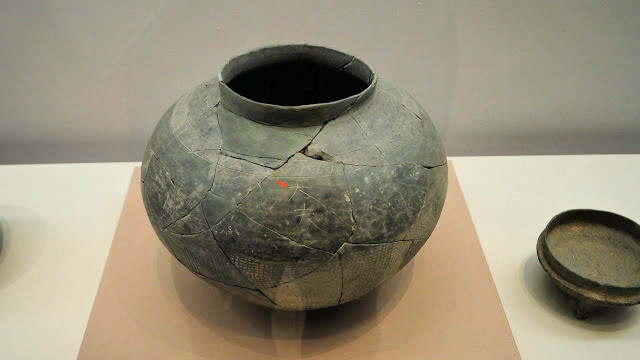 A clay pot with etched Hanja (Chinese characters) on it
A clay pot with etched Hanja (Chinese characters) on it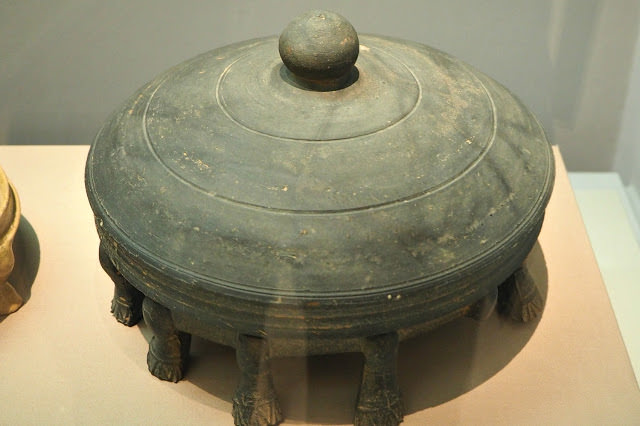 A cauldron with legs made during the Baekje Kingdom
A cauldron with legs made during the Baekje KingdomAmazing Gilt-Bronze Cap
A Baekje gilt-bronze cap is a decoration symbolizing one's social status. It was usually found in the tomb of rulers.
Its form takes on a cylindrical shape, and there are some caps with prong-shaped ornaments attached to them.
There were many cases where the gilt-bronze cap was buried with high-quality articles such as gilt-bronze shoes, and Chinese ceramics.
They are usually found in relics of the period when Baekje was consolidating the Mahan confederacy.
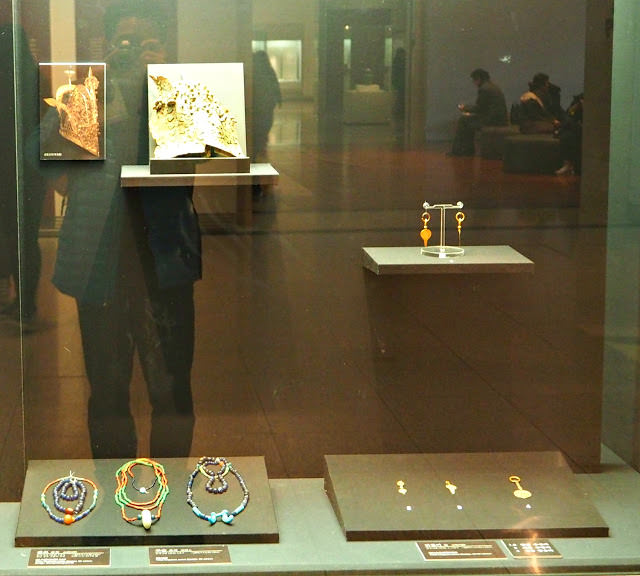 Baekje Kingdom's gilt-bronze cap and other accessories including gold earrings, necklaces, and bracelets
Baekje Kingdom's gilt-bronze cap and other accessories including gold earrings, necklaces, and braceletsForeign Exchanges in Baekje
Baekje firmly established its international status in East Asia through foreign trade.
They have not only adopted advanced culture from China, and creatively developed it but also introduced it to Japan.
Sea routes played an essential role in the foreign trade fro the Baekje. The Jungmakdong remains in Buan had been a place where religious services were held to pray for a safe voyage.
This was also a strategic location connecting Japan, the southern and western coast of Korea, and China. In addition to this, Baekje performed various forms of national religious services, including services for the ancestors.
Baekje's Regional Controls
The geological conditions of the Yeongsangang River basin, namely being close to the seas while also being situated amidst rivers and fertile plains, gave rise to robust communities.
These people gradually came under the influence of Baekje as the kingdom expanded its power to the south.
During the 4th~5th century, the large tombs entombing a large outer coffin transformed into stone chamber tombs in the late 5th century. Subsequently, the tombs change into a Baekje style stone chamber tomb made by setting up place stones.
The people who built these tombs are assumed to be regional Baekje powers who exercised influence based on their economic power from the Yeongsangang River basin.
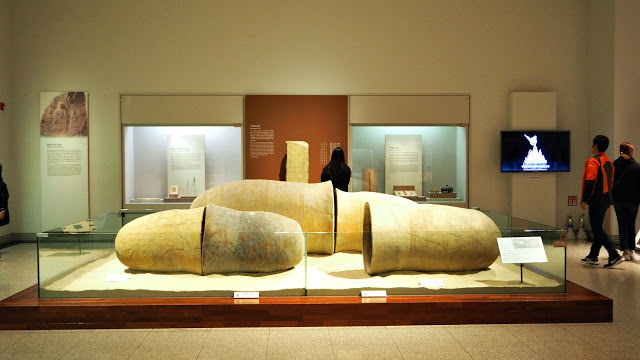 Clay Jar Coffins
Clay Jar CoffinsReviving Baekje Culture During the Ungjin Period
The Ungjin Period of Baekje refers to the time between 475 when King Munju moved the capital to Unjin and 538 when King Seong set up the capital at Sabi.
During the reign of King Muryeong, when the kingdom recovered its stability with the balance between the royal authority and aristocrats, enjoys were sent to the Liang of Southern Dynasties to strengthen diplomatic ties.
Baekje succeeded the culture of the Hanseong period during the Ungjin period and brought in Chinese culture and introduced it to Silla, Gaya, and Japan.
It was the period when Baekje restored its national power and laid the groundwork for revival.
Moving on From Ungjin to Sabi
King Seong (r. 523~554) who ascended to the throne after King Muryeong moved the capital of Baekje to Sabi in 538 and established a foundation for national prosperity.
Politically, he reorganized the governing system of the central government and regional provinces to establish a governing political system centered on royal power.
The Sabi period reached the height of Baekje culture, which had been accumulated over the years from the Hanseong period, and in art and religion, Buddhist culture brilliantly blossomed.
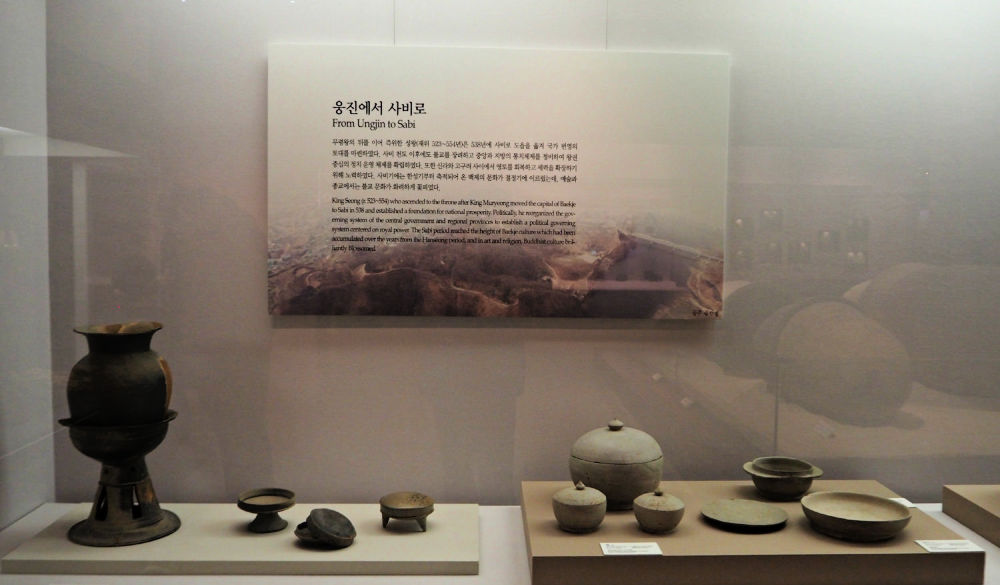 Clay potteries and an incense burner
Clay potteries and an incense burnerThe Sabi Fortress
Sabi Fortress consists of the inner fortress divided by roads centered around the royal palace, a defensive fortress called Busosanseong, and outer walls surrounding the royal palace.
The inner part of the fort consisted of 5 bu areas, where the existence of bu was verified through rocks, roof tiles, and wooden tables etched with the name of the administrative regions.
It is assumed that the royal palace site had been located on the southern foot of Mount Busosan.
Buddhist Culture of Baekje
Buddhism was introduced to Baekje from the Eastern Jin of China during the first year (384) of King Chimnyu's reign in 384.
Of particular note, it can be seen that Buddhist culture flourished during the Sabi Period as many Buddhist temples such as Jeongnimsa Temple and Wangheonsa Temple were built around the current area of Buyeo.
The Buddhist temples of Baekje have typical features of most temple layouts, including a pagoda and one main building where the inner gate, pagoda, main building, and hall are aligned in a straight line running north and south.
The statue of Buddha is refined and takes on a gentle appearance. Multiple metal craft works, including the Baekje Incense Burner, display the excellence and creativity of Baekje Buddhist culture.
The Buddhist culture of Baekje was introduced to Japan and influenced the formation of Japanese Buddhist culture.
 Clay Buddhist Bodhisattvas produced during the Baekje Kingdom which adopted the belief as the kingdom's religion
Clay Buddhist Bodhisattvas produced during the Baekje Kingdom which adopted the belief as the kingdom's religionBaekje's Administration of Iksan
King Mu (r. 600~641) was a king who decorated the glory days of Baekje culture, and there are many relics related to King Mu remaining in the area of Iksan.
The Wanggung-ri remains were initially constructed as a royal palace but were later changed into a Buddhist temple. Twin Tombs were stone chamber tombs made in the 7th century.
The wooden coffin buried together was made out of Japanese umbrella-pine, and the coffin ornaments are also extravagant. The Mireuksa Temple is a Buddhist temple built with Maitreya's belief as its background.
It is the largest Buddhist temple in the Three Kingdoms period. Iksan was an area regarded as a significant location until the fall of the Baekje royal family.
Ornaments of Baekje Aristocrats
Ornaments, apart from its function of beautifully decorating the body, displayed the social status of the person wearing it.
The ruling class of Baekje used various ornaments, and the representative ones were silver diadem ornaments and belt ornaments.
The silver diadem ornament was a long strip of a silver plate made into a branch with flower bud decorations. It coincides with document records showing that the hats of aristocrats were decorated with silver flowers.
Jar Coffins (9th Tomb at Sinchon-ri excavated in Naju in 1917)
In the Yeongsangang River basin, gigantic jar coffins, which were buried in pits with high earthen mounds, were standard in the 4th and 5th centuries.
From the jar coffins, gilt-bronze crowns, gilt-bronze shoes, necklaces, swords with a ring pommel, and so on were unearthed, suggesting that the occupant of the tomb was highly influential in this region.
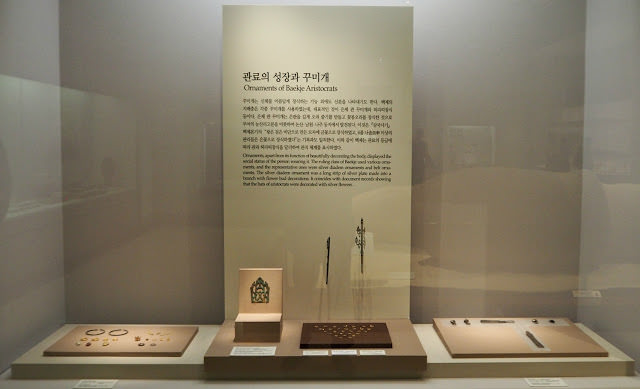 Accessories of the aristocrats during Baekje Kingdom's golden age
Accessories of the aristocrats during Baekje Kingdom's golden ageStele (a replica)
This is a stele discovered at Busosanseong Fortress at Buyeo. It is assumed to have been made during the 14th year (654) of King Uija's reign.
The characters were engraved by trimming one side of granite rock and dividing it up into rectangular sections, and then etching the letters.
Currently, only four lines remain, and each line has fourteen characters engraved vertically. The motive behind a person named 'Sataekjijeok' building the main building and a pagoda of the temple is engraved on the stele.
This is an excellent material for having a glimpse into the stele and calligraphic style at that time.
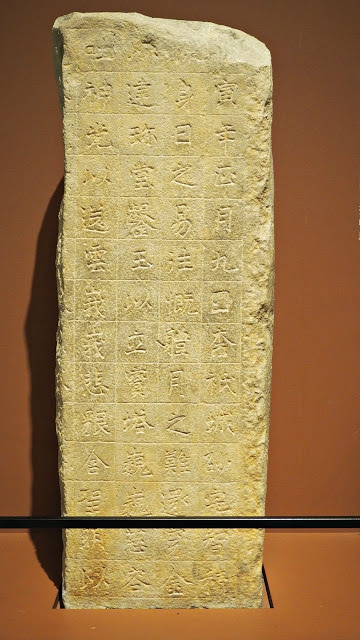 A stele discovered at Busosanseong Fortress at Buyeo. It is assumed to have been made during the 14th year (654) of King Uija's reign (replica only at the National Museum of Korea).
A stele discovered at Busosanseong Fortress at Buyeo. It is assumed to have been made during the 14th year (654) of King Uija's reign (replica only at the National Museum of Korea).Characters of Baekje
The epigraph of Baekje becomes an excellent material for showing the historical facts of the time through the characteristics of excavated remains.
The wooden tablets substituted for the paper before the paper was invented as letters were written or etched with knives on long and thin pieces of wooden boards.
These wooden tablets were widely used for uncomplicated document records or tags and graffiti or writing practice.
At Pungnaptoseong Fortress, pottery and bricks engraved with characters were excavated, which confirmed that Chinese characters were used even during the Hanseong period.
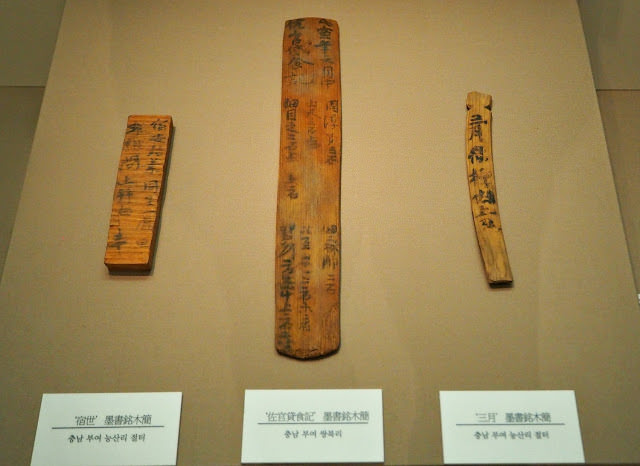 Simple etched records in Chinese characters made during the Baekje Kingdom period.
Simple etched records in Chinese characters made during the Baekje Kingdom period.Designed Bricks
There were eight kinds of patterned bricks excavated at Oe-ri, Buyeo.
The rectangular bricks have a consistent size, and because there are grooves on the side of four corners, they can be fixed in connection.
Baekje's Patterned Bricks with excellent picturesque quality has excellent value as the aspects of art, architecture, religion, and even ideology at the time can be examined through these artifacts.
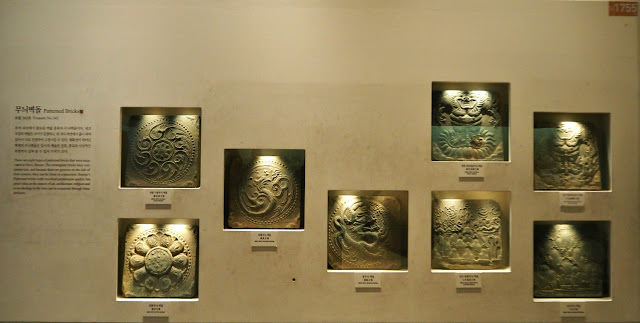 Clay bricks with patterns of various elements including mythical animals
Clay bricks with patterns of various elements including mythical animals
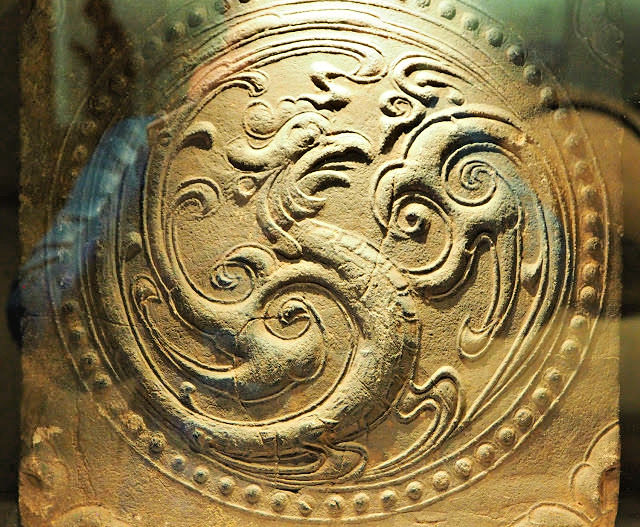 A phoenix-patterned clay brick on exhibition at the National Museum of Korea, Seoul [Abbie] A phoenix-patterned clay brick on exhibition at the National Museum of Korea, Seoul [Abbie] |
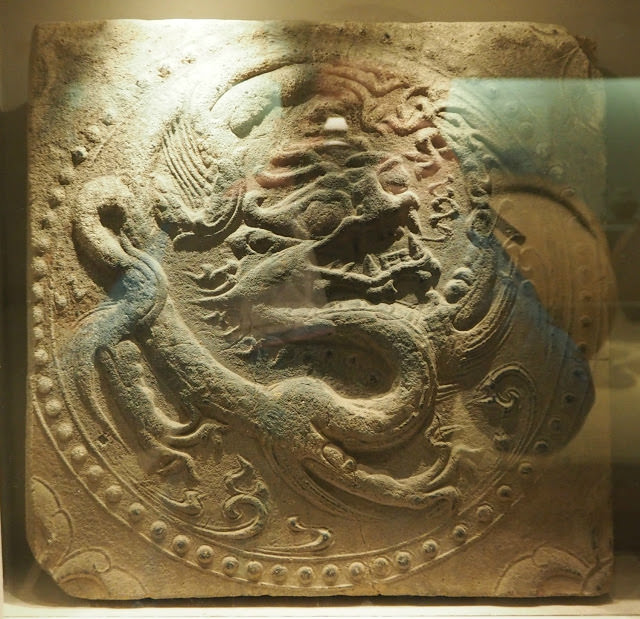 A clay brick with dragon pattern A clay brick with dragon pattern |
Roof Tiles Styles
The roof tiles of Baekje establish Baekje's unique style, mainly consisting of lotus flower patterns as it goes through the Ungjin and Sabi periods.
During the Ungjin Period, the kingdom of Baekje newly adopted the roof tile production technology of Liang of Southern Dynasties.
The production of roof tiles also gained momentum as many Buddhist temples were built after moving the capital to Sabi.
The roof tile production technology of Baekje was introduced to Silla as well as Japan. Doctor Wa, who was sent to Japan, influenced the development of Asuka roof tiles.
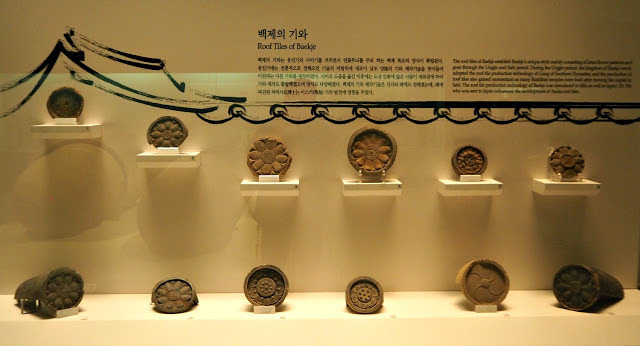 Designs and patterns of roof tiles during the Baekje Kingdom period.
Designs and patterns of roof tiles during the Baekje Kingdom period.How to Get to the National Museum of Korea
You can see more artifacts made during ancient Korea's Baekje Kingdom at South Korea's national museum. Yes, they are exciting and entertaining as well as educational.
The museum is enormous and houses thousands of ancient artifacts, both donated and excavated after many decades of work and research.
You can check out more about the National Museum of Korea here and see how to get there using public transports. It is in Seoul, so it is quite easy to find.
I hope this is helpful in your search for the Baekje in ancient Korea.
Have a good day!
- Home
- Historical Attractions
- Baekjae Kingdom
Get Exciting Activities
Book one of our exciting activities today to experience the thrill of a lifetime! Take advantage of this opportunity and secure your spot in advance.
Hotel Map Guide
Find your affordable, accessible, and comfortable hotel in Seoul at Agoda.Com. See the hotel map below...
Hotel Booking Guide
Find affordable and amazing hotels on Agoda.com using the search box below. Book now to enjoy great discounts and save!
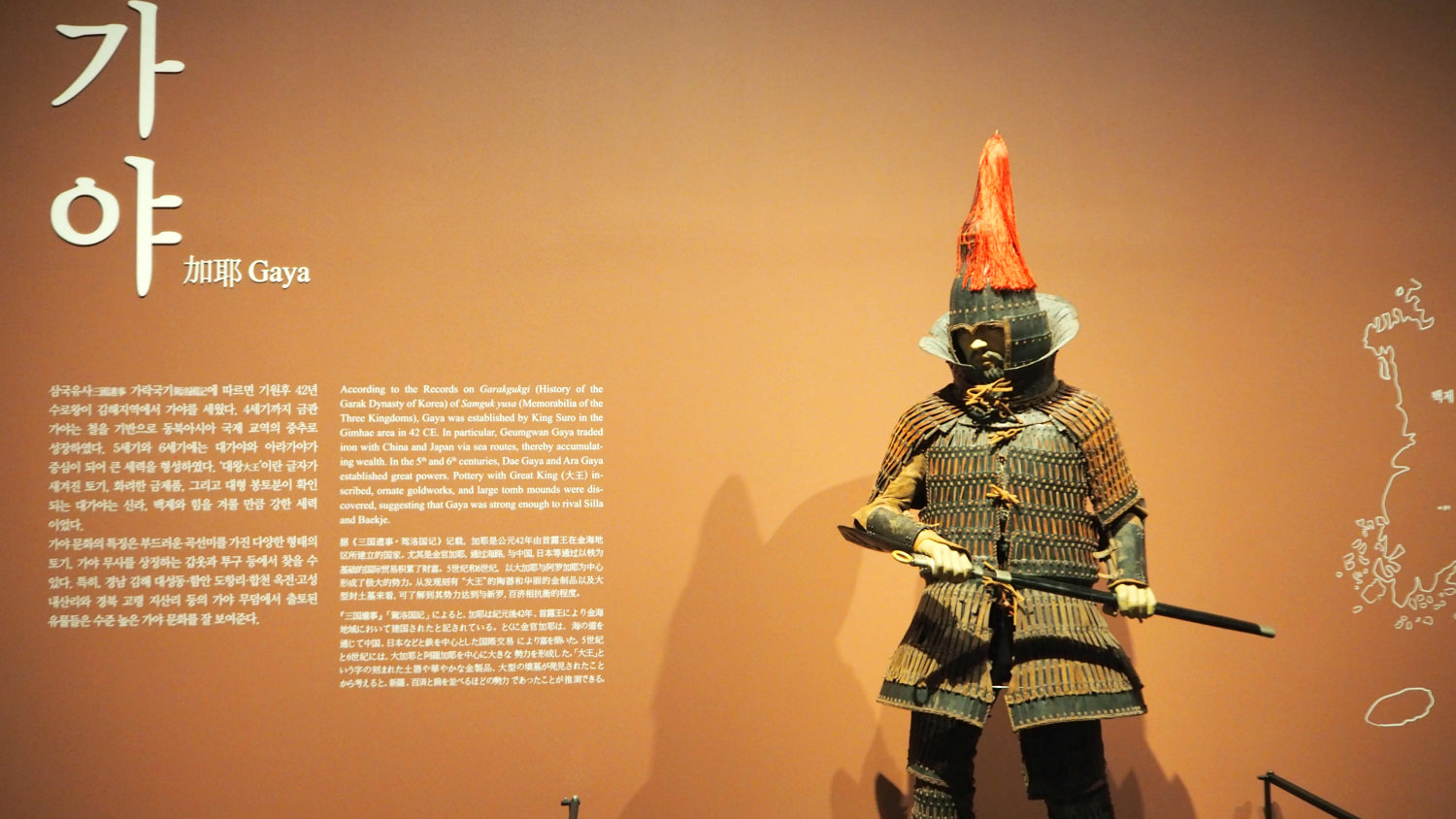
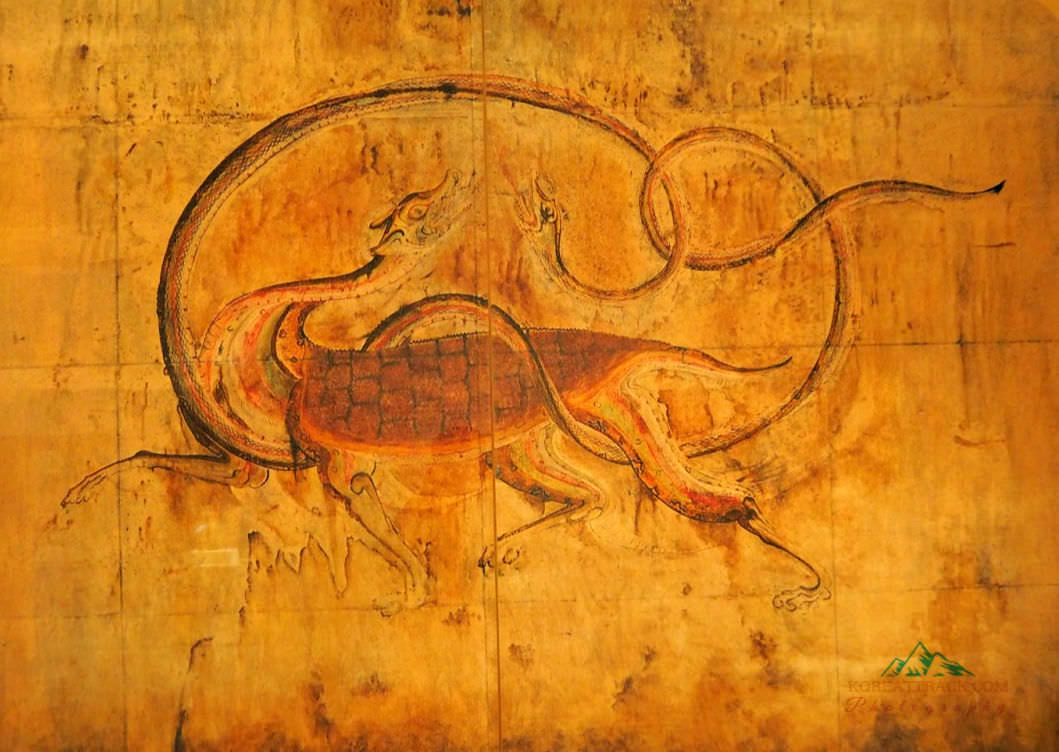
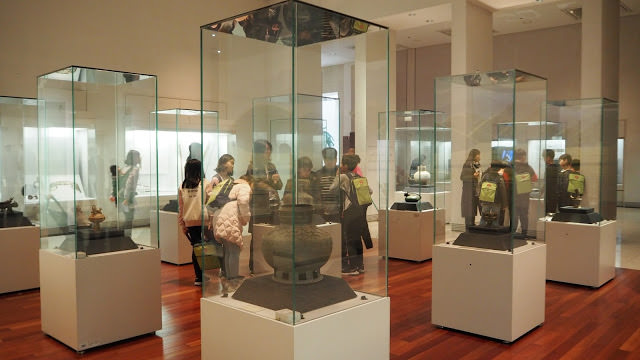




New! Comments
What do you think about this page? Leave me a comment in the box below.